Screw compressors or screw air compressors are explained along with basics, definition, components, different types, working principles, applications, advantages, disadvantages, etc. Let’s explore screw compressor or screw air compressor!
What are Screw Air Compressors?
Let’s get into the basic understanding and definition of screw compressor.
Screw Compressor Basics
Compressors are the machines that are used for different sets of work regarding pressures. There are different kinds of compressors that are used for other processes. Screw compressors are among the most efficient kinds of compressors used for various refrigeration and air processes.
- It is also used for different process applications for quite a long time.
- From the past two decades, screw compressors have gained massive popularity in the natural gas industry and various gas accumulation applications.
- It has provided additional growth to this sector.
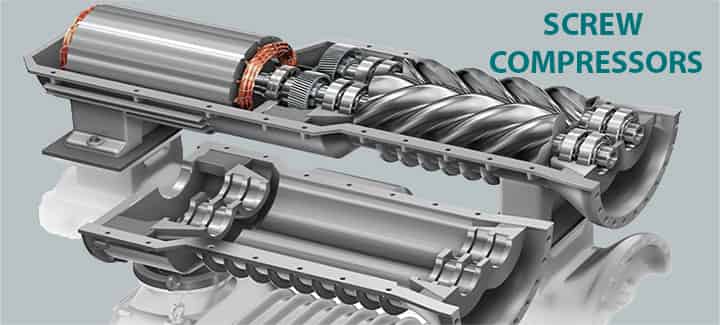
Most industrial applications coincide with reciprocating compressors, but the cost associated and different complications made us look for an apt alternative. This screw compressor has been on an advancement journey that makes them a proper alternative for industrial usage.
Those who are unaware of the screw compressors are at the right place. Here we are providing all the relevant details about the same. From the core definition to the limitations, this excerpt will help you grab a fair share of knowledge about this machine. We will start with the proper definition of screw compressors, and then we will discuss the different information about this machine.
Screw Compressors Definition?
The screw compressor is one of the compressors with excellent mechanical properties, and it is among the positive displacement compressors.
- It is equipped with some of the simplistic parts that enable the gas forces applied on the screw to be effectively balanced.
- It is equipped with bearing support that provides support to the gate rotor.
Numerous components help in the core working of the screw compressor. It is quite effective to get an overview of the same as it helps understand the whole mechanism.
Main Components of Screw Compressors
While understanding the holistic concept of the screw compressor, it is significant to understand the mechanism. Here we have listed the main components of the screw compressors:
- Screw elements or rotors
- Chamber for compression
- Suction air filter at inlet
- Oil filters
- Bearings
- Suction Valve
- Discharge valve
- Electric Motor
- Oil Tank, Oil Filter, and Air-Oil Separator
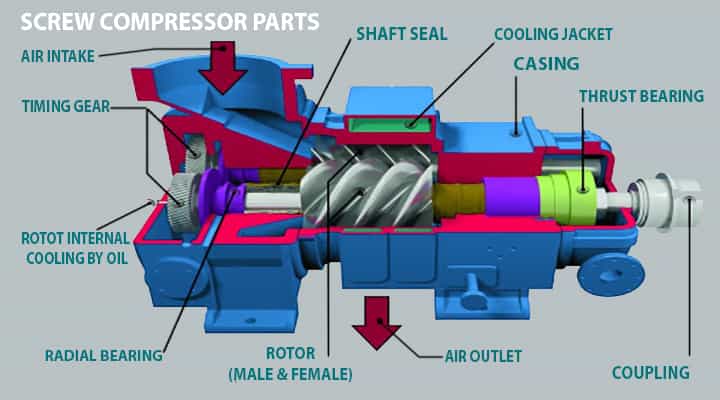
Screw Elements or Rotors
The screw compressor has an air end that compresses the air. These are designed with precision and need proper knowledge of the system. It is equipped with two screws.
- The bigger screw is known as female, while the other one is known as male.
- The female screw comes into rotary motion due to the electric motor.
- The female screw is comparatively more robust than the male screw.
- Here the two screws need oil treatment that is necessary for preventing or decreasing the abrasion on screws.
The primary purpose of the air end is to compress the oil and air mixture.
Chambers for Compression
- Screws are kept in a chamber where compression happens.
- As pressure increased inside the chamber, it should be air-tight, safe to operate.
- The numbers of chamber, depends on type of compressors.
- It may be multiple numbers as well.
- No vibration allowed for chamber.
- There is a lubricating system to limit the increase of temperature inside the chamber during the process.
There is various material may be used for chamber based on the application, however, most widely used materials are,
- Cast steel
- Cast iron
Suction Air Filter at Inlet
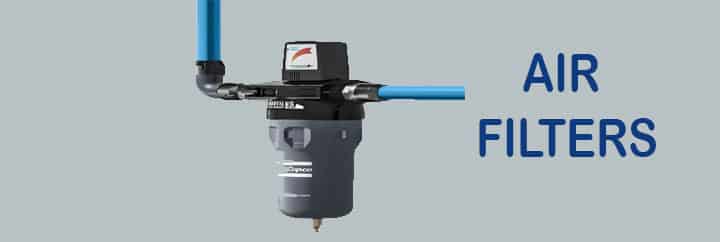
- Air contains dust, mist, or pollutants and it is required to remove from the air.
- Filters are provided to clean the air.
- Filters need to clean frequently or requirement basis, based on the climatological conditions.
- An alarm is synchronized in case filter cleaning is required.
Oil Filters
- Oil is used for the lubrication system.
- In the compression system, due to rotating parts oil is necessary.
- Oil filters are used to filtrate the contamination from the oil.
Bearings
In screw compressor, anti-friction roller and ball Bearings are used,
- Due to rotation of screws, bearings are provided.
- It helps to balance properly.
- It reduces frictional forces as well as reduces losses.
- It also helps to rotate the screw freely.
The bearing used are may be,
- radial bearings
- axial bearings /thrust bearing
Suction Valve
In the compressor, it is quite necessary to control the airflow. For this process, a suction valve is used, which controls the airflow.
- It works under the control of pneumatic and electrical control. The mounting of the suction valve is on the air end.
- During the compression operation, the suction valve gets controlled by the control unit.
- When the compressor stops the suction, the valve gets closed down, preventing the air escape.
It is essential to keep a check on the suction valve as it provides longer life to the compressor.
Discharge Valve
- Air is compressed in the chamber and it is required to exit to store or for further use.
- The discharge valve is used for the final release.
- It helps to control the flow.
Electric Motor
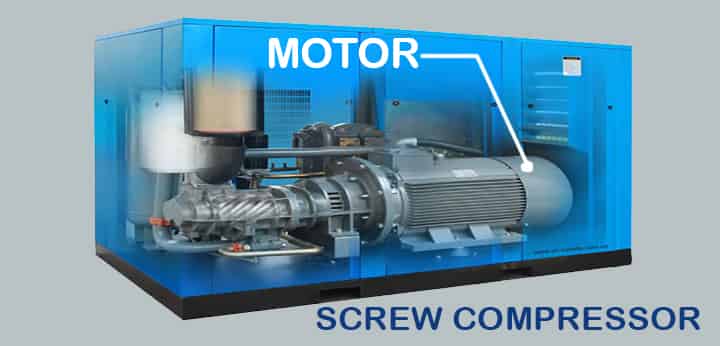
One of the essential parts of the screw compressor is its electric motor. It is the power source of the compressor.
- There are different types of systems that take place in screw compressors.
- In the Direct acute systems, the transmission or the operation is carried by bearing, while in V-belt driven systems, the transmission process is carried out through V-belt, and the power is transmitted to the Air-end.
- This provides maximum power to the compressor and helps them to work efficiently.
Oil Tank
The oil tank is a component in which compressed air oil is being stored in. The oil goes through the oil filter, and the separator gets the air with oil grains. If the same temperature remains under the specified temperature, then it is sent to the oil filter directly; otherwise, it is transferred to the air radiator.
- The process of segregation of oil grains from the air takes place, and once again, the process is repeated.
- The cooling of separated air occurs in the Air-Oil radiator; after that, it goes into the air dryer.
How Does a Screw Compressor Work?
The mechanism of the screw compressor can easily be depicted with these steps, brace yourself to understand the core working of the components that enable the compressor to work.
Check a very NICE ANIMATED VIDEO from MAN Diesel & Turbo,
from MAN Diesel & Turbo,
Step#1
- Air enters into the screw compressor through air filters and a suction valve.
- All dust particles, contaminants will be cleaned in the air filters.
Step#2
- The main step of the mechanism involves the male rotor lobe’s meshing, which will roll out the female rotor flute. The suction gas will be filled in the vacated space due to the male rotor.
- Gradually when the rotors are enmeshing, the flute volume increases continuously.
- The gas continues to enter the flute unless the rotor lobes out of the mesh.
- After the enmeshing with each other, the flute passes by the edge of the suction port, ultimately closing down from the system.
Step#3
- After the above process, the point where the flute keeps traveling at the edge of the suction port, here maximum volume is generated.
- It effectively represents the suction volume of the flute.
- The suction volume is entrapped with the flute of the suction process.
- In this step, the rotors continue to rotate and mesh together along the bottom. The same process as step 2 takes place.
Step#4
- Here comes the discharge process in the whole mechanism of the screw compressor.
- The discharge process in the screw compressors is different from other compressors as there are no valves in the screw which doesn’t allow gas to escape from the flute.
- The positioning of the discharge port is vital along the rotors’ axis as it helps the compression process to complete, and then only the discharge process begins.
- The above discharge process took place until all female rotors were rolled out by mail rotor completely.
- There are no trapped pockets of gas remaining in the machine, resulting in the high volumetric efficiency of the screw compressors as the pressure differentials increase substantially.
Special Notes
- Screw Compressors are equipped with two discharge ports which are called axial and radial ports.
- The axial port is butterfly-shaped, while the radial is a V-shaped cut in the side valve.
- Here, the discharge process occurs when the rotor’s top end gets in contact with the radial cut-out area.
- Oil cooling circuits, water cooling circuits are shown in a schematic below.
Schematics of Screw Compressor
A simple schematics of a typical screw compressor is captured below with air, oil & water circuits.
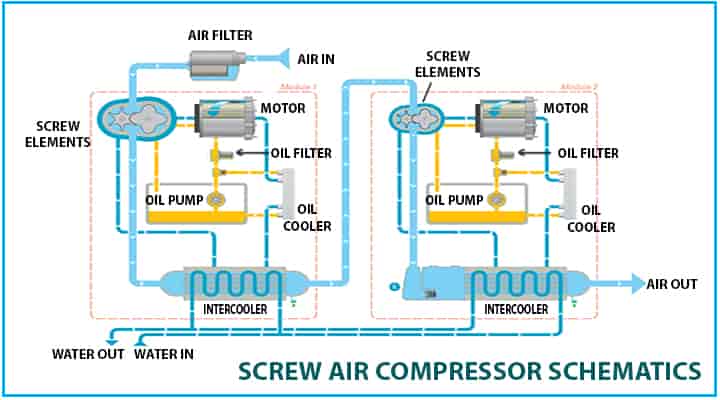
Types of Screw Compressors
Mainly there are two types of screw compressors available for usage. These effectively include,
- oil-injected rotary screw compressors and
- oil-free rotary screw compressors.
Here we are providing the elaborative analysis of those two types:
Oil-Injected Rotary Screw Compressors
The core working of an oil-injected screw compressor is based on the compressor’s oil during the actual compression cycle.
- Gradually the oil separator removes the oil, and it gets clean and compressed air.
- Almost most of the oil content is retained, but a bit of it passes through the separator and leaves the compressor together with compressed air. This is known as oil carryover.
This kind of screw compressors are incapable of producing oil-free air and cannot be used in those places where oil-free air is the need. Apart from that, it can be used for most of,
- machinery,
- workshops,
- factories,
- Refrigeration and HVAC industries,
- Processing of hydrocarbon,
- Process gas, etc.
However, the oil injection helps in rust prevention as well and enables the machine to run smoothly.
Oil-Free Rotary Screw Compressors.
The second type of screw compressors works the same as the oil-injected ones, but there is no oil presence, rather than that it uses air.
- As there is no oil injection during the compression cycle and it has two stages in the whole compression process.
- In this, the first stage involves air compression; this process effectively heats up the air.
- It is passed through the intercooler before getting onto the final stage.
Oil-free rotary compressors are mainly used in the following areas, to eliminate the contamination problems,
- Food and beverage industry,
- Wastewater treatment,
- Chemical processing,
- Critical areas in the oil and gas field,
- Electronics industries,
- Painting in automobiles,
- Medical and pharma industries,
- Textile industries etc.
Features of Screw Compressors
The features of screw compressors make them quite efficient. Numerous features can help it to attain maximum efficiency as compared to other types of compressors. Here we are discussing some of the essential features of the screw compressors that provide a vivid idea about the same:
Low power consumption: The rotary screw compressor is more of positive displacement equipment that doesn’t need any discharge valves or suction parts.
- It can easily automatically start the suction of volume; simultaneously, there is a reduction in part load power consumption.
- Compared to other conventional compressors, screw compressors can run on low power and opt for a more comprehensive operating range.
- With the lower maintenance cost features, it can provide practical benefits.
- The low power consumption also helps in producing much lower vibration levels than other piston machines also.
Minimal Maintenance: Screw compressors are equipped with fewer numbers of components. The only significant rotary parts are the male and female rotors.
- Screw compressors are not equipped with pistons, valves, piston rings, crankshafts, or connecting rods which require time to time maintenance.
- With the unavailability of these critical parts, the annual maintenance costs are negligible.
- It is pretty common to get long-lasting operation of screw compressors without any maintenance or repairs.
- When you compare screw compressors with other types of compressors, then the overall costing goes down substantially.
Optimum Turn Down capability: Screw compressors generally offer maximum turndown capability, which can be up to 85-90% with the optimum part load.
- Turn down capability comes typically into consideration when gas or external driver speed controls are present.
- This effectively makes a machine quite efficient.
- The flow rate is abnormal, and operating conditions the screw compressors provide for easy and effective operation.
- These are pretty attractive for the users at those places.
- The screw compressors are equipped with capacity control that can be calibrated automatically or manually, which effectively fulfills all the demands.
- The screw compressor feature helps the same to adjust capacity within the machine.
Optimal Compression Ratios: Compression ratios are the significant specifications that define the overall efficiency of the compressors.
- Screw compressors operated explicitly from 2 to 20 ratios of compression in sync that maintain high volumetric efficiencies.
- These efficiencies are critically achieved by providing the optimal lubricants into the machine during the compression process.
- The lube oil is essential for these compressors as they effectively reduce the temperature of the process gas at the time of discharge.
Operation at maximum temperature: As compared to other compressors, screw compressors operate at much lower pressures. They are typically restricted to 4 ratios of compression per stage.
- These screw compressors are needed to prevent poor volumetric efficiencies, rod loading, and excessive discharge temperatures.
- For this, inter cooling and multi staging are the basic processes.
- We use reciprocating compressors for those places where there is a need for more than four compression ratios.
- This provides better adiabatic efficiencies.
- However, screw compressors require much lesser power in this case.
Apt for wide operating ranges: One of the best features that makes screw compressors quite efficient is their working on wide operating ranges. While operating screw compressors at these ranges, the user needs to provide minimal or no changes.
- This makes it quite suitable for the natural gas industry, where operating conditions and flow rates keep on changing as per need.
- It doesn’t need rod loading or discharge temperature limits similar to reciprocating ones.
- These screw compressors don’t need changing cylinders, restaging, or change of cooler sections.
Portable size: Screw compressors have maximum capacities and need minimal space for installation.
- The physical size of the screw compressor is way smaller than other compressors.
- The portable size of the screw compressor makes it quite effective and helps the user or in industries.
- With this, effective operation can be attained without giving much space.
Minimal vibration: Screw compressors are equipped with only two prominent moving parts that operate in a circular motion; these screws can produce much lower vibration when they get into the circular motion.
- The installation cost gets massively lower as the screw compressors don’t need that much of a firm foundation.
- This is one of the essential features that makes it quite effective.
Minimal installation costs: Screw compressors are comparatively of high reliability, which results in lower maintenance costs. This also results in lesser downtime as compared to other compressors.
Applications of screw compressors
When it comes to applications, screw compressors are used in a wide range of industries. Numerous attributes make it quite effective for all users. Here we are providing some of the credible applications of the screw compressors:
Screw compressors are commonly used in a variety of industries. Here is the list of technical usage of the screw compressors in those industries.
- Process refrigeration
- HVAC system
- Natural gas applications
- Individual wellhead boosters
- Low-pressure gathering systems
- Low stage boosters
- Fuel gas compression
- Solution gas
- Vapor recovery compression systems.
- Acid gas applications
The above usage is widely used for conventional natural gas processing, which depends on specific gravity. It can be used on very lightweight gases such as hydrogen and other ones.
However, the most effective application of gas compressors is quite common in conventional natural gas processing. This is because it has excessive turndown capability and can be operated at different operating ranges. In places where there is a need for cost-cutting, screw compressors are used effectively.
Advantages of Screw Compressor
There are numerous advantages of screw compressors that make them worth using in any setup. It can be used for a wide range of applications due to the following advantages:
- Long-lasting life: Screw compressor can provide maximum longevity as compared to another air compressor. The overall lifespan of the screw air compressor is around 70000 to 90000 hours.
- Maximum efficiency: Screw compressor can provide continuous operation without catering to any problems, which makes them quite efficient. Due to this reason, it is also capable of meeting high demand.
- Quiet and noiseless operation: The screw compressor is known for its minimal vibration and noise production while in operation. In most cases, it is one of the prominent factors that come into play. Apart from the above advantages, there are some of the core disadvantages of screw air compressors.
Disadvantages of Screw Compressors
These disadvantages should also be considered while opting for screw compressors.
- Specific maintenance need: The maintenance provided to these screw compressors is quite complicated and cannot be given by anyone. The complexity in the maintenance is on the higher node, and it needs proper professional help. It can only be maintained by highly skilled personnel who know this machine’s components and mechanism.
- Input cost: The initial input cost involved in the screw compressor is on the higher side as compared to the other air compressors. The core reason for this higher cost is that these are comparatively more durable and reliable than most of the other compressors.
Now, don’t be confused this screw compressor with a reciprocating compressor!
Difference Screw Compressor vs Reciprocating Compressor
Let’s see the basic difference between screw and reciprocating compressor, in a tabulated form,
| Screw Compressor | Reciprocating Compressor |
| Rotary screw compressor uses screws for the compression as well as to produce compressed air. | Reciprocating compressor use piston arrangements for the compression as well as to produce compressed air. |
| Low wear and tear due to less moving parts | High wear and tear due to many rotating or moving parts. |
| Noise is negligible | It produces noise |
| Suitable for continuous supply. | Suitable for intermittent supply. |
| Normally air cooled. | Normally air cooled, but for high capacity it is water cooled. |
| Requirement of space is less. | Requirements of space is more. |
| Oil free screw compressors doesn’t have oil at the outlet. | It consists of oil at the outlet. |
| Moderate air flow and less head application. In case of high head application screw compressor is not suitable. | Low flow rate and high head application |
| Capital cost is high | Capital cost is less. |
| Highly Reliable and maintenance cost is less. | Reliable but not in high capacity. Maintenance cost is high due to various moving components. |
| High energy efficient, energy loss is less | Comparatively low energy efficient with respect to Screw compressor, energy loss is more. |
Conclusion
As we have provided all the relevant information about screw air compressors, there are lots to know about. With all the attributes of this efficient machine, it is pretty helpful for those who want to use them in their workshops or industries. The prominent process of air and refrigeration is needed for almost all industrial purposes. Nowadays, you cannot think of any industrial processes that don’t use compressors. With the increased costing and maintenance charges in different compressors, it is pretty essential to get insights into one of the best compressors. Screw compressor comes under that category and helps users in the best possible ways. Keep a check on the above information and help yourself to grab a fair share of information about these compressors.
